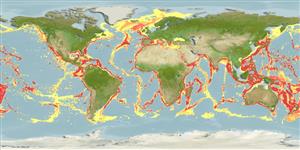Common names from other countries
Environment: milieu / climate zone / depth range / distribution range
Sinh thái học
Tầng nổi; Mức độ sâu 100 - 3000 m (Ref. 110525), usually 900 - 1100 m (Ref. 106682). Tropical; 44°N - 35°S, 180°W - 180°E (Ref. 96968)
Circumglobal in tropical and temperate waters.
Length at first maturity / Bộ gần gũi / Khối lượng (Trọng lượng) / Age
Maturity: Lm ? range ? - ? cm Max length : 13.0 cm ML con đực/không giới tính; (Ref. 96968)
Total length is up to 30 cm (Ref. 96968). One type of a living fossil which showed very little change since it first appeared. The species could turn itself 'inside out' to avoid predators. Inhabits deep waters of open oceans (Ref. 843). Depths range from 600 to 1,200 m. This is a mid-water species. The long filaments in pits between the first two arm pairs may be used to feel for or chemically detect prey. Live animals observed in situ typically orient in the water column with the dorsal mantle surface facing upwards and one filament extended well beyond the arms. Disturbed animals pull the arms and web over their body to take on an inverted shape that exposes the black skin and cirri, on the oral surfaces of the webs. In addition to the large four photophores, this species can produce light on its arm tips and squirt luminous clouds from the arm tips consisting of discrete glowing particles, which can glow for up to 10 minutes (Ref. 96968).
Life cycle and mating behavior
Chín muồi sinh dục | Sự tái sinh sản | Đẻ trứng | Các trứng | Sự sinh sản | Ấu trùng
Members of the class Cephalopoda are gonochoric. Male and female adults usually die shortly after spawning and brooding, respectively. Mating behavior: Males perform various displays to attract potential females for copulation. During copulation, male grasp the female and inserts the hectocotylus into the female's mantle cavity where fertilization usually occurs. Life cycle: Embryos hatch into planktonic stage and live for some time before they grow larger and take up a benthic existence as adults.
Jereb, P., C.F.E. Roper, M.D. Norman and J.K. Finn. 2014. (Ref. 96968)
IUCN Red List Status (Ref. 130435)
CITES status (Ref. 108899)
Not Evaluated
Not Evaluated
Human uses
| FishSource |
Các công cụ
Thêm thông tin
Age/SizeSự sinh trưởngLength-weightLength-lengthHình thái họcẤu trùngSự phong phú
Các nguồn internet
Estimates based on models
Preferred temperature
(Ref.
115969): 3.4 - 11.6, mean 5.7 (based on 2508 cells).
Vulnerability
Low vulnerability (10 of 100).
Price category
Unknown.
